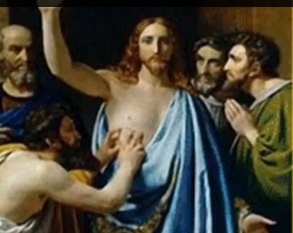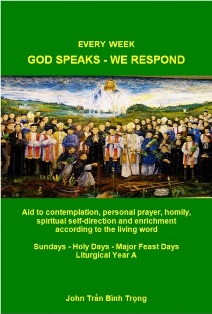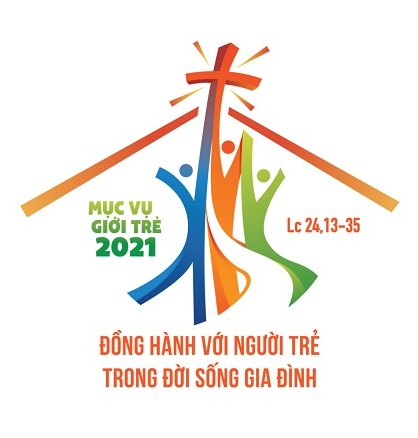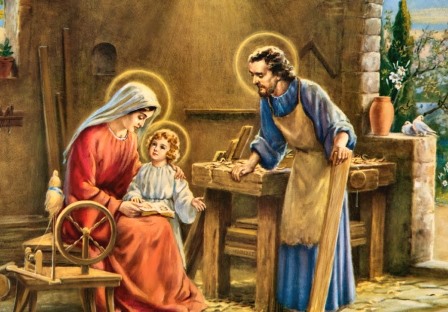 2 Sunday of Easter, Year A
2 Sunday of Easter, Year A
Acts 2:42-47; 1Pt 1:3-9; Jn 20:19-31
Introduction: This is a homily/Scripture reflection in a book, titled: ‘Every Week God Speaks We Respond’, Cycle A, intended to be published in the future by Reverend John Tran Binh Trong.
It was published in Vietnamese in the US 2007 and republished in Viet Nam 2010. To keep the author’s writing style, this homily has not been edited and may not be by a hired hand. However, if readers would like to point out mistake(s) in spelling and grammar and/or to suggest English phrases and expressions, it would be greatly appreciated by the author, whose English is not his mother tongue and who did not live in the US until his adulthood. Passive sentences are used intentionally in this context as to avoid using the first personal pronoun ‘I’ when applicable. That might be associated with any idea of egotism, in accord with the French saying, known as: ‘Le moi est haissable’ (The ego is detestable).
When Mary of Magdala and the women went back to tell the apostles about the empty tomb and the appearance of the angels who told them to carry the good news to the apostles, they thought it was the product of women’s imagination (Mk 16:11; Lk 24:11). Possibly, the apostles were influenced by the Jewish law at that time, not accepting the witnesses of women in court. That was why they did not take the women’s report on Jesus’ resurrection seriously in their community of discipleship. John was the only one who believed that his master had risen when he saw the empty tomb and the head cloth rolled up lying separately from the wrappings.
The death of Jesus was a bombshell to the Apostles, destroying all their hope. In three years of their discipleship, the apostles heard Jesus predicting he would suffer and die and rise on the third day (Mt 16:21; Mt 17:23; Mt 20:19; Mk 8:31; Mk 9:31; Mk 10:34; Lk 9:22; Lk 18:33; Jn 2:19) according to the Old Testament scripture. They still did not understand the meaning of his word of prediction about his resurrection (Ps 16:10, Hos 6:2). They also witnessed his power through his miracles, yet they did not keep in mind.
When they were praying in their locked room for fear of the Jews, Jesus appeared to them and said: Peace be with you (Jn 20:19). This time Thomas was absent. When the Apostles told Thomas about their master’s appearance to them, he refused to believe. He demanded to see the Lord, to hear his voice, to touch the nail marks on his body, before he could believe in his resurrection. Thomas was a practical and pragmatic man. Once Jesus said he would go and prepare a place for them, Thomas questioned Jesus that they would not know where he would be going. So how could they know the way (Jn 14:5)? We might blame Thomas for his persistent unbelief of Christ's resurrection.
However, Thomas doubted on this one occasion only. After Jesus had personally appeared to him, Thomas made his profession of faith personally, firmly and resolutely: My Lord and my God (Jn 20:28). His profession of faith was worthy to be an example and to be repeated hundreds, thousands of times for those who are doubtful about Jesus’ resurrection.
In our times of experimental science and technology, people want to verify all hypotheses. However, faith is not a science. Faith is a gift from God. Faith is not something we can hold fast in our hands, put in a deposit box in the bank, or bury in the ground. It is something that we have to find ways to maintain. Since faith is a gift from God, we do not need to rely on reason to understand what we believe, because faith and understanding are on two different levels.
We cannot use our limited reason to understand the mysteries of religion such as the mystery of the Trinity, the mystery of the incardination, the mystery of the resurrection, but only to accept them with faith. Suppose we can understand a mystery of religion, then what is called religion is no longer a religion, but merely a system of philosophy or science. The question here is why we do not understand, yet we believe? To believe means to trust those who are trustworthy. We believe in the resurrection of Christ because we rely on scripture, on Jesus’ appearances to the apostles, on the witnesses of the apostles to his resurrection. We believe in the resurrection of Christ because we rely on millions and millions of other Christians in the world, who have followed the risen Lord faithfully day by day.
In the Jewish court at that time, women could not act as witnesses. Thus, the witness of Mary of Magdala was invalid. In any time, people consider one witness as no witness: Testis unus, testis nullus. In this case, there were eleven apostles as witnesses and two more witnesses of the two disciples on the road to Emmaus (Lk 24:35). The ten apostles accepted death to bear witness to their master’s resurrection.
Yet, to believe in God does not mean that there is no more problem of life. Thus, we can see people with strong faith, but still face difficulties in life: diseases and sufferings in body and mind, spirit and soul. Faith should help us face illnesses, diseases and difficulties in daily life. Faith has entered our lives gradually. With daily observation, we realize God leads us step-by-step and day-by-day through different paths of life from infancy through adulthood, to old age, sometimes it’s smooth, other times it is rough.
Today is the Divine Mercy Sunday. In 1931, Jesus appeared to Saint Faustina Kowalska, a Polish nun, telling her to spread devotion to his divine mercy. Jesus further asked that a Novena to the Divine Mercy be made beginning on Good Friday. On each day of the novena, the Divine Mercy chaplet is prayed on ordinary rosary beads. A prayer to the Divine Mercy is repeated like Hail Mary: For the sake of His Sorrowful Passion, have mercy on us and on the whole world.
A prayer of the first day of the Divine Mercy Novena Chaplet: [1]
Most Merciful Jesus, whose very nature it is to have compassion on us
and to forgive us, do not look upon our sins but upon our trust
which we place in Your infinite goodness.
Receive us all into the abode of Your Most Compassionate Heart,
and never let us escape from it.
We beg this of you by Your love which unites You
to the Father and the Holy Spirit.
Eternal Father, turn Your merciful gaze upon all mankind
and especially poor sinners, all enfolded
in the Most Compassionate Heart of Jesus.
For the sake of His sorrowful Passion show us Your mercy,
that we may praise the omnipotence of your mercy for ever and ever. Amen.
John Tran Binh Trong
_________________________________
[1]. The Divine Mercy Message and Devotion. Revised edition with selected Prayers from the Diary of St. Maria Faustina Kowalska. Fr. Seraphim Michalenko, MIC with Vinny Flynn and Robert A. Stackpole. Marian Press. Stockbridge, MA 01262



 Every Week God Speaks – We Respond, Cycle A was published Online in the US. The introduction of the book is recorded at “Sách của Tác giả Chủ trương, Column 1.
Every Week God Speaks – We Respond, Cycle A was published Online in the US. The introduction of the book is recorded at “Sách của Tác giả Chủ trương, Column 1.

 Năm Mục Vụ Giới Trẻ 2021. HĐGM ấn định một chương trình Mục vụ Giới trẻ 3 năm với các chủ đề tương ứng: Năm 2020: Đồng hành với người trẻ hướng tới sự trưởng thành toàn diện.
Năm Mục Vụ Giới Trẻ 2021. HĐGM ấn định một chương trình Mục vụ Giới trẻ 3 năm với các chủ đề tương ứng: Năm 2020: Đồng hành với người trẻ hướng tới sự trưởng thành toàn diện. Năm Thánh Giu-se: Nhân kỷ niệm 150 năm Đức Giáo hoàng Pio IX chọn thánh Giuse làm Đấng Bảo Trợ Giáo Hội Công Giáo, Đức Phanxicô đã ban hành Tông thư “Patris corde” – Trái tim của người Cha – và công bố “Năm đặc biệt về thánh Giuse” từ
Năm Thánh Giu-se: Nhân kỷ niệm 150 năm Đức Giáo hoàng Pio IX chọn thánh Giuse làm Đấng Bảo Trợ Giáo Hội Công Giáo, Đức Phanxicô đã ban hành Tông thư “Patris corde” – Trái tim của người Cha – và công bố “Năm đặc biệt về thánh Giuse” từ  Năm “Gia đình Amoris Laetitia” 2021 về “Vẻ đẹp và niềm vui của tình yêu gia đình” do Bộ Giáo Dân, Gia Đình và Sự Sống tổ chức, được Đức Phanxicô khai mạc dịp Lễ Thánh Giuse
Năm “Gia đình Amoris Laetitia” 2021 về “Vẻ đẹp và niềm vui của tình yêu gia đình” do Bộ Giáo Dân, Gia Đình và Sự Sống tổ chức, được Đức Phanxicô khai mạc dịp Lễ Thánh Giuse 
